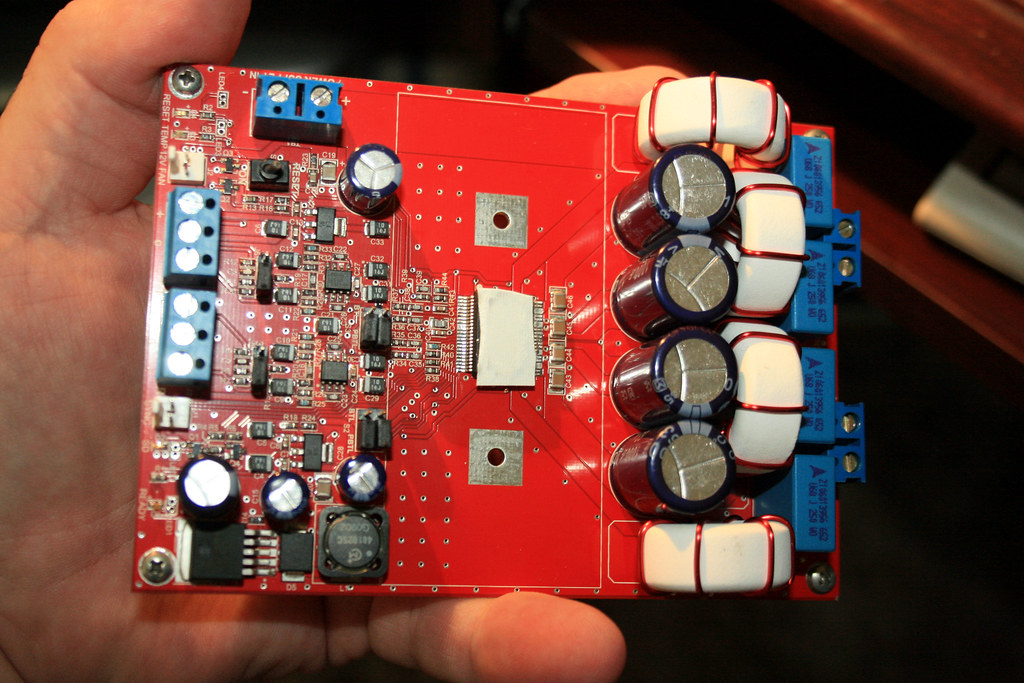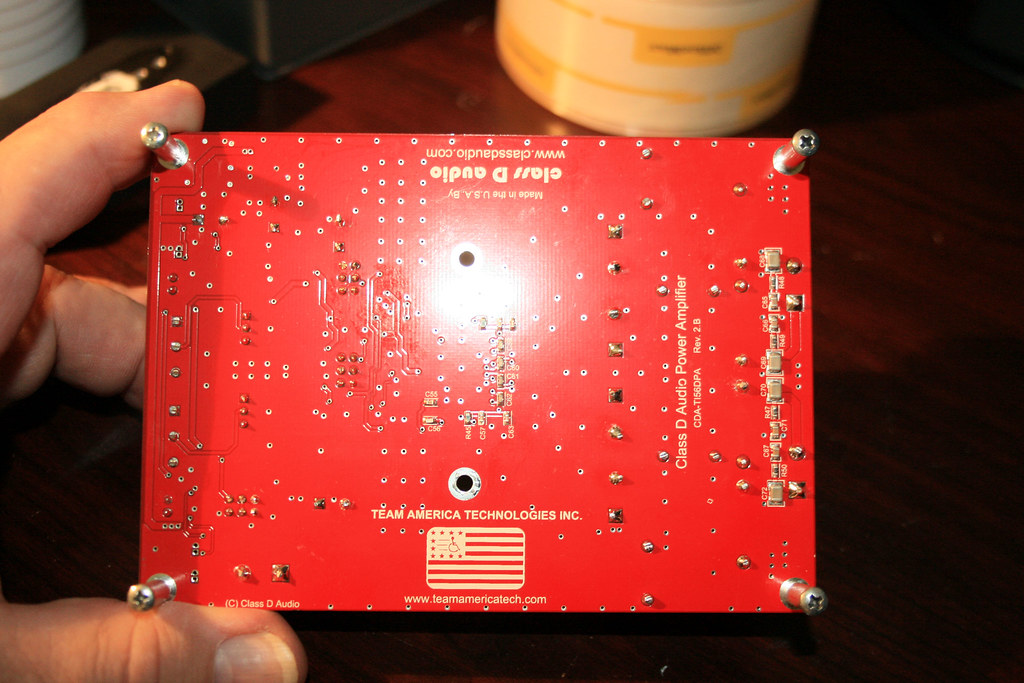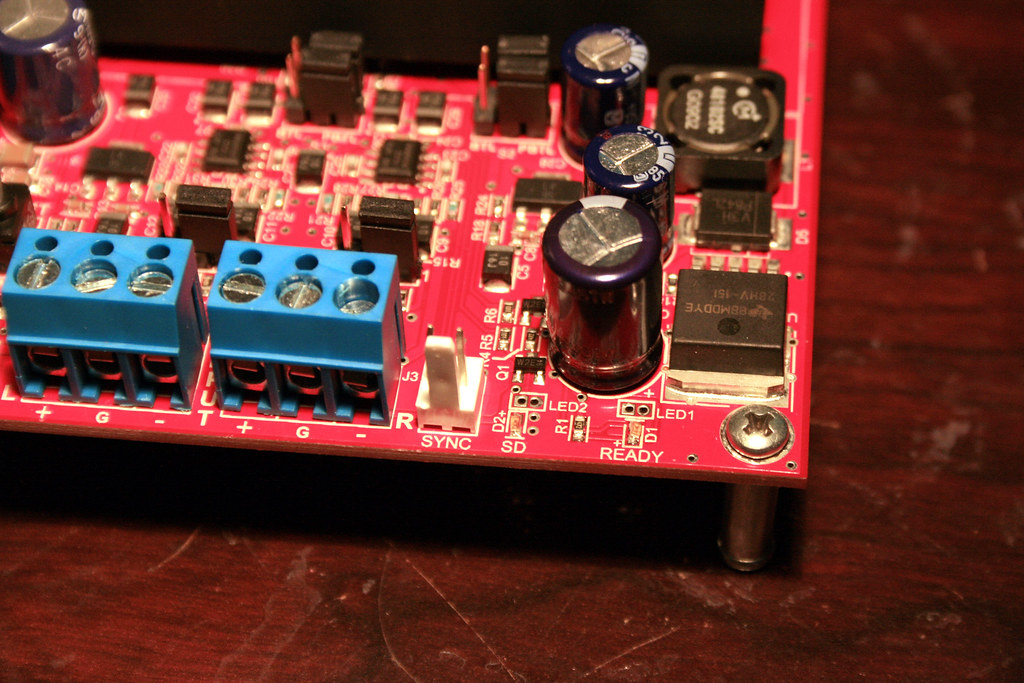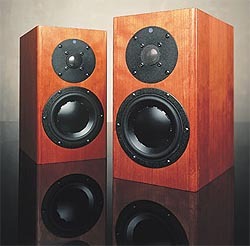I was sifting through some E-bay stuff today and came across a California based company that makes some incredible looking class d amplifier modules... they actually use high grade parts... So I ordered one of the new 600 watt T.I. based boards based on the TAS5630. Looking forword to this as I have never even been in contact with any class D amplifier since the original Infinity Class D amplifier back in the late 1970's. This thing has some amazing claims and is reasonably priced at $155.00. Has anyone here built an amp with this chip yet or used this copmpany's products? I was pleased at the support I got on the questions I had... everyone was answered within 5 minutes of me sending them e-mail!!
My only comment on the physical constraints of this board is I wish they had put a ribbon cable type terminal board for hooking up external LEDs.
http://classdaudio.com/index.php?main_page=index Home Page
http://classdaudio.com/index.php?main_page=product_info&cPath=1&products_id=17 600 watt T.I. Page
Mark
My only comment on the physical constraints of this board is I wish they had put a ribbon cable type terminal board for hooking up external LEDs.
http://classdaudio.com/index.php?main_page=index Home Page
http://classdaudio.com/index.php?main_page=product_info&cPath=1&products_id=17 600 watt T.I. Page
Mark
Last edited:
Mine came yesterday by Priority Mail. Hooked it up to my variable bench supply and running it at about 45 volts... end less current available since the supply can do 20 amps. This Class D board requires but a single 50 volt supply to operate. Initially I didn't like what I heard.. a bit ragged top end... but later as the amp warmed up a bit things started to get better. It's certainly a very different sound from what I am used to (Pass and Krell). One thing I will attest to is the abundant power this tiny board can put out!!! It is also stable all the way down to 2 ohms. Plenty of status LEDs are on the board... Reset, Shutdown, Hi Temp, and Ready. There are also connection points on the board to tie external indicator LEDs for these and I know fopmr the T.I. data sheet that this chip also has a pin for Clip Indicator and I wonder why they did not bring this out to at least a tie point??? There is a two pin connector for a 12 volt fan and another 2 pin socket for external sync. I ran it all afternoon yesterday and the heat sink only got mildly warm even when pushing this amp at very loud levels for long periods. So unless you're running 2 ohm loads I shouldn't think that either a fan or larger heatsinking would be needed. More later...
Mark
Mark
Thanks Mark for the update. I'm very interested in hearing more about this amp and it's sound, pics would be great. In your opinion, how is the build quaility and layout?
My second comment is we know this is not a "D class amp" design but it's design and concept has the same spirit as a D class amp. I for one would be very curious to find out how this amp sounds compared to a good D class amp.
It would be great if some how we can get a decent review between the D Class amp, a A/B amp like the one above and a Chip amps. Out of all of these which design is producing the best sound/music (I know subjective) at the same level of build quality?
My second comment is we know this is not a "D class amp" design but it's design and concept has the same spirit as a D class amp. I for one would be very curious to find out how this amp sounds compared to a good D class amp.
It would be great if some how we can get a decent review between the D Class amp, a A/B amp like the one above and a Chip amps. Out of all of these which design is producing the best sound/music (I know subjective) at the same level of build quality?
Last edited:
There were ramblings in a other thread ( http://www.diyaudio.com/forums/showthread.php?p=1878688&highlight=classdaudio.com#post1878688 ) about how this amp (http://classdaudio.net/ & http://classdaudio.com/ both are same guy & company located in So. CAL) should not be in the D Class forum because it was a a/b amp. I myself an not sure of which class this amp belongs too but more importantly I'm curious about it's performance and it's sound/music qualities.
Pic of the 250w x 2 / 500w x 1 amp
Pic of the 250w x 2 / 500w x 1 amp
An externally hosted image should be here but it was not working when we last tested it.
Last edited:
The amp in the above photo is based on an International Rectifier chip of some sort. I haven't bothered to look it up.
The board I bought is built around the Texas Instruments TAS5630 DKD package. This is what T.I. says right on their spec sheet... So if you want to argue if it's Class D or not you should argue with them. It certainly belongs in this forum.
"The TAS5630 is a high performance analog input Class D amplifier with integrated closed loop feedback technology(known as Purepath tm HD)with the ability to drive up to 300 W stereo into 4 or 8 ohms speakers fomr a single 50 volt supply."
If you want to read the rest pf the schpeil its here:
http://focus.ti.com/docs/prod/folders/print/tas5630.html
The build quality is quite good although I have not actually looked at individual parts to assess their quality. They seem to have followed T.I.'s build practices very closely which is probably why it's been operating extremely stable just sitting on top of one of my speakers...
In the lower photo you can see the on board 12 volt supply and two of the indicator LEDs. Also the solder pads for the off board LEDs. Electrolytics are 105 deg.c rated. You can slso see the two OPA-1632 active balanced op-amps and their regulator transistors. Although the TAS-5630 requires an input cap I did'nt see one at first glance. Perhaps this OPA input stage eliminated the need for the input caps... Running single ended or active balanced only requires removing two jumpers, likewise for bridge mono mode. It sure is alot better built than the typical Asian board is. I give this guy alot of credit for going heads on against that market. I wonder how long it'll be before someone over there steals his design? I've started my stopwatch!
I looked up Team America and they are a handicapped organization. Apparently they assemble them.
Edit: T.I. does reccomend insulating the heatsink from the heat slug... I don't know if the slug is at an active DC level or what yet...



The board I bought is built around the Texas Instruments TAS5630 DKD package. This is what T.I. says right on their spec sheet... So if you want to argue if it's Class D or not you should argue with them. It certainly belongs in this forum.
"The TAS5630 is a high performance analog input Class D amplifier with integrated closed loop feedback technology(known as Purepath tm HD)with the ability to drive up to 300 W stereo into 4 or 8 ohms speakers fomr a single 50 volt supply."
If you want to read the rest pf the schpeil its here:
http://focus.ti.com/docs/prod/folders/print/tas5630.html
The build quality is quite good although I have not actually looked at individual parts to assess their quality. They seem to have followed T.I.'s build practices very closely which is probably why it's been operating extremely stable just sitting on top of one of my speakers...
In the lower photo you can see the on board 12 volt supply and two of the indicator LEDs. Also the solder pads for the off board LEDs. Electrolytics are 105 deg.c rated. You can slso see the two OPA-1632 active balanced op-amps and their regulator transistors. Although the TAS-5630 requires an input cap I did'nt see one at first glance. Perhaps this OPA input stage eliminated the need for the input caps... Running single ended or active balanced only requires removing two jumpers, likewise for bridge mono mode. It sure is alot better built than the typical Asian board is. I give this guy alot of credit for going heads on against that market. I wonder how long it'll be before someone over there steals his design? I've started my stopwatch!
I looked up Team America and they are a handicapped organization. Apparently they assemble them.
Edit: T.I. does reccomend insulating the heatsink from the heat slug... I don't know if the slug is at an active DC level or what yet...



Last edited:
There were ramblings in a other thread ( http://www.diyaudio.com/forums/showthread.php?p=1878688&highlight=classdaudio.com#post1878688 ) about how this amp (http://classdaudio.net/ & http://classdaudio.com/ both are same guy & company located in So. CAL) should not be in the D Class forum because it was a a/b amp. I myself an not sure of which class this amp belongs too but more importantly I'm curious about it's performance and it's sound/music qualities.
Perhaps you are thinking of classd.ltd.uk. They have nothing to do with classdaudio.com or classaudio.net.
The amplifier you are referring to above is in fact a class-d amplifier based on the IRS2092.
Last edited:
I thought TI recommended using a high quality thermal transfer compound, simply to make sure there's good transfer of heat from the chip to the sink.
Later on in the data sheet they say the heat sink should have a good connection with the PCB ground.
There's nothing as far as I can tell, that says the heat sink should be electrically isolated from the chip.
Later on in the data sheet they say the heat sink should have a good connection with the PCB ground.
There's nothing as far as I can tell, that says the heat sink should be electrically isolated from the chip.
I think 5th element may be right on the thermal slug. I'm not sure what I was thinking there... musta been a brain f**t. I'll remove the thermal tape on mine next time I pull the sink off.
As for sound... At first listening it sounds very "solid state". After a long warmup the edge seems to smooth out a bit... I noticed this same thing today as I did yesterday. This amp very definitely sounds excellent after warm up especially if the recording is very good. The high end becomes very detailed after warmup and the sight edge seems to disappear. I am building the BPA 300 watt chip amp but thats a while off yet although I just about have all the other missing parts here. So hopefully by years end we'll be able to compare BPA-300 chip amp, This Class D amp, several of the Pass amps and the KSA-50 and 100. I just have to round up the old gang for a shoot out.
Mark
As for sound... At first listening it sounds very "solid state". After a long warmup the edge seems to smooth out a bit... I noticed this same thing today as I did yesterday. This amp very definitely sounds excellent after warm up especially if the recording is very good. The high end becomes very detailed after warmup and the sight edge seems to disappear. I am building the BPA 300 watt chip amp but thats a while off yet although I just about have all the other missing parts here. So hopefully by years end we'll be able to compare BPA-300 chip amp, This Class D amp, several of the Pass amps and the KSA-50 and 100. I just have to round up the old gang for a shoot out.
Mark
Mark,
Not sure if this applies to this amp but what do you think about using instead a copper sink as a mod.?
Peter Daniel who makes beautiful chip amps found that "instead of aluminum, a copper bar would be more advantegous as it takes heat away better from the devices than aluminum" "I use copper in a Patek amp mostly to increase the amp weight, influence sonic signature a bit by controlling resonances". Just a thought as I see you had already removed the sink.
Thanks for your previous post's, I'm looking forward to any more comments or observations about the design, parts and sound.
I would be curious to how this amp will sound compare to a Hypex or ICE.
Cheers,
PS: "Arctic Silver" is a really good thermal compound.
Not sure if this applies to this amp but what do you think about using instead a copper sink as a mod.?
Peter Daniel who makes beautiful chip amps found that "instead of aluminum, a copper bar would be more advantegous as it takes heat away better from the devices than aluminum" "I use copper in a Patek amp mostly to increase the amp weight, influence sonic signature a bit by controlling resonances". Just a thought as I see you had already removed the sink.
An externally hosted image should be here but it was not working when we last tested it.
Thanks for your previous post's, I'm looking forward to any more comments or observations about the design, parts and sound.
I would be curious to how this amp will sound compare to a Hypex or ICE.
Cheers,
PS: "Arctic Silver" is a really good thermal compound.
Last edited:
I'd have no problem with using copper but it's about 6 to 10 times more expensive then alumnium is. Copper conducts heat better but then we are not dealing with the amount of heat that even a class AB chip amplifier produces, are we? A nice largish copper CPU heat sink wold work really well! I scanned through the T.I. lit again and I believe I definately had the heat sinking thing wrong. Next time I pull the sink off I will very surely give it some arctic silver. I have some here some place... My wonderful wife who tolerates my eccentric electronics hobby has put up with the whole house being an electronics lab amnd things are well.... here and there and everywhere.
I have the amp on and am listening as I type... Sounds great but again very different from what I am used to. You might call it hyper clean... the detail is unbelievably clear but not exaggerated either. Female vocals have a smoothness that is uncanny! I am driving it with a Grounded Grid tube preamp at the moment until I get the 12B4 set back up. You live close enought to them to go have a look see... and perhaps get us a few pics for the thread? They are in Orange, CA. and apparently do allow walk ins. All you have to do is e-mail them... I bet you have a response within 5 min!
Edit.. P.S. This amp does need an hour plus time to warm up... I wonder why this is...?

Would utilizing this sink leave Peter Daniel in the dust???? Just kidding... Peter''s a great guy and I've built several of his projects...
I have the amp on and am listening as I type... Sounds great but again very different from what I am used to. You might call it hyper clean... the detail is unbelievably clear but not exaggerated either. Female vocals have a smoothness that is uncanny! I am driving it with a Grounded Grid tube preamp at the moment until I get the 12B4 set back up. You live close enought to them to go have a look see... and perhaps get us a few pics for the thread? They are in Orange, CA. and apparently do allow walk ins. All you have to do is e-mail them... I bet you have a response within 5 min!
Edit.. P.S. This amp does need an hour plus time to warm up... I wonder why this is...?

Would utilizing this sink leave Peter Daniel in the dust???? Just kidding... Peter''s a great guy and I've built several of his projects...
Last edited:
This amp does need an hour plus time to warm up... I wonder why this is...?
Dare I say it's your ears (or rather what's between them) that need to warm up to the amp?

I'll drop him a email and see about stopping by, yes I live somewhat close by but with the traffic around here it would almost be quicker to your house. I would think getting him on board could be a win-win for the DIY forum and himself. I did read somewhere that he was not aware of the audiophile community but was hoping to come up with a model for us eccentric hobbyist as he getting lot's of requests.
Yes the copper is more expensive but how much are we really talking about, a stock of .5-1lb max? I like the idea about adding mass to help control resonances and making the whole structure stiffer as an added bonus to the benefited cooling. Plus, it just sounds cool (no punt intended, well maybe).
My plan is find an ideal amp source for a small dual mono integrated with a remote for a pair of Totem Model One's with a 84 db @ 3.5ohm load, not exactly the easiest request. Peter Daniel and a partner have come up with a remote volume & input control that looks promising and not expensive.
The sound you describe is sounds a bit forward and digital especially since you already have a tube pre-amp hooked up to it.
Yes the copper is more expensive but how much are we really talking about, a stock of .5-1lb max? I like the idea about adding mass to help control resonances and making the whole structure stiffer as an added bonus to the benefited cooling. Plus, it just sounds cool (no punt intended, well maybe).
My plan is find an ideal amp source for a small dual mono integrated with a remote for a pair of Totem Model One's with a 84 db @ 3.5ohm load, not exactly the easiest request. Peter Daniel and a partner have come up with a remote volume & input control that looks promising and not expensive.
The sound you describe is sounds a bit forward and digital especially since you already have a tube pre-amp hooked up to it.
Edit: I just checked prices for square stock. My apologies, copper is indeed quite dear. Now I now why cities are having such a hard time from poachers pulling/ripping out copper wiring.
There were some ok prices on eBay:
http://business.shop.ebay.com/i.html?_nkw=copper+BAR&_sacat=12576&_trksid=p3286.m270.l1313&_odkw=copper+square&_osacat=12576

With that sink you could crank the volume all the way to 11!
There were some ok prices on eBay:
http://business.shop.ebay.com/i.html?_nkw=copper+BAR&_sacat=12576&_trksid=p3286.m270.l1313&_odkw=copper+square&_osacat=12576

With that sink you could crank the volume all the way to 11!
Last edited:
Dare I say it's your ears (or rather what's between them) that need to warm up to the amp?
Definitely NOT my ears. After an extended warm up this thing sounds superb but before warmup sounds harsh. I've been doing some work in the other room so I don't have to listen too closley for a while. I have Krell KSA50 Clone Aleph 30 and pair of Aleph 2's I've compared it to.
My plan is find an ideal amp source for a small dual mono integrated with a remote for a pair of Totem Model One's with a 84 db @ 3.5ohm load, not exactly the easiest request. Peter Daniel and a partner have come up with a remote volume & input control that looks promising and not expensive.
Am not familiar with those speakers but they are pretty inefficient. Just give the amp time to warm up or leave it on all the time. I'm heading down to RaElco this morning to see if they have any largish surplus 48 or 50 volt switching power supplies to run this thing. Something with at least 10 amps or more...
You can always come join us here if the traffic is real bad. Pisser is that the traffic between Batstow and Las Vegas is pathetically slow at times. Once I get to Vegas I head north through Pioche and then through the West Desert to get back to SLC. It can actually be quicker and if you like desert country as much as I do then it's also more enjoyable.
Mark
Last edited:
I guess my next question is what type of power supply would be best for this amp? Has SMPS made any inroads over a traditional toroid transformer? I noticed in reading that anecdotal opinion a toroid was preferred.

http://www.stereophile.com/standloudspeakers/820/index.html
Totem is a imaging monster but really needs a lot of good juice to shine for good bass and full sound otherwise it will sound shallow and thin. Paired with the right gear, they're sound awesome and very addicting. My next step would be to acquire Merlin TSM monitors.

http://www.stereophile.com/standloudspeakers/820/index.html
Totem is a imaging monster but really needs a lot of good juice to shine for good bass and full sound otherwise it will sound shallow and thin. Paired with the right gear, they're sound awesome and very addicting. My next step would be to acquire Merlin TSM monitors.
- Status
- This old topic is closed. If you want to reopen this topic, contact a moderator using the "Report Post" button.
- Home
- Amplifiers
- Class D
- Class D Audio, Who are these guys?